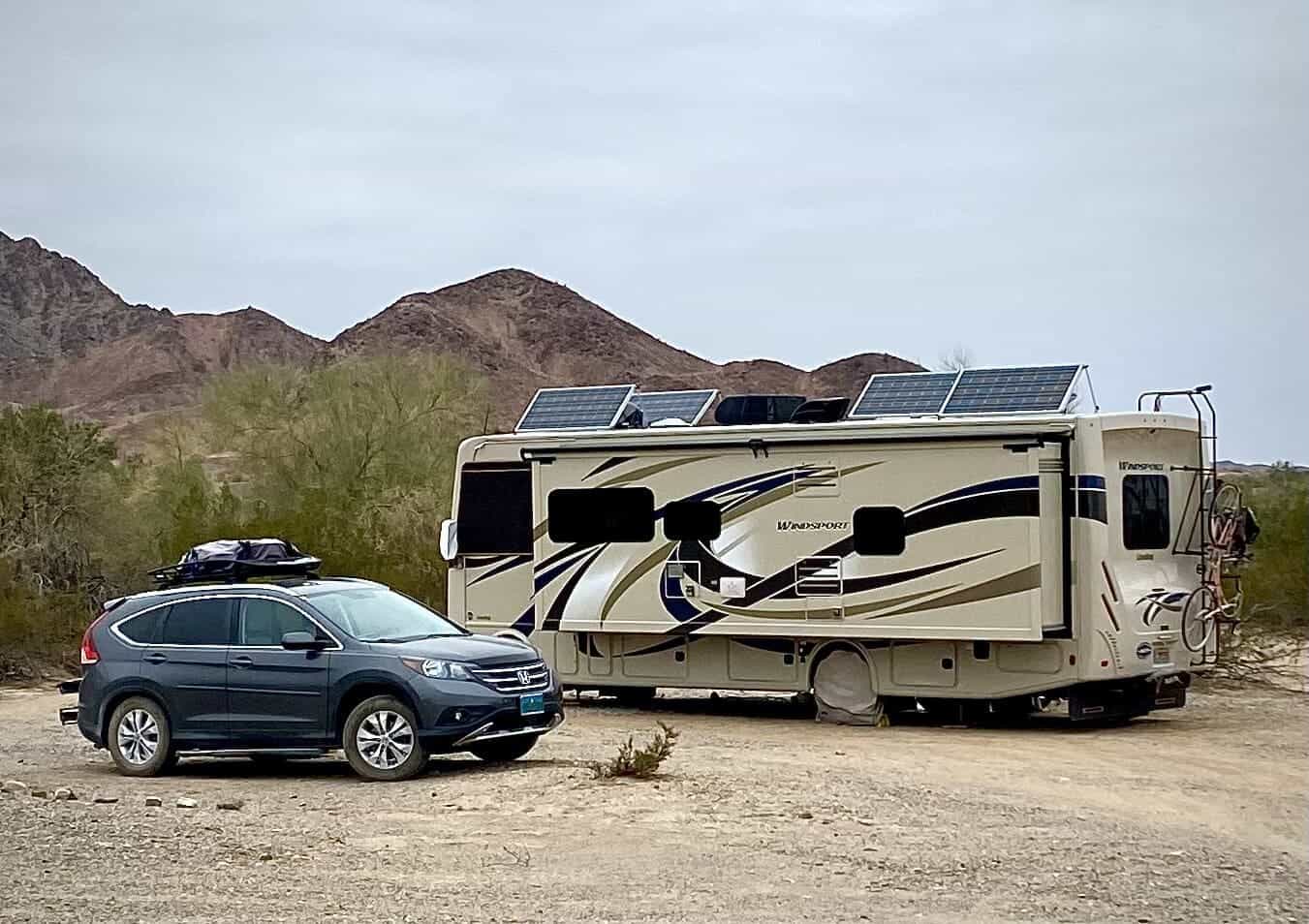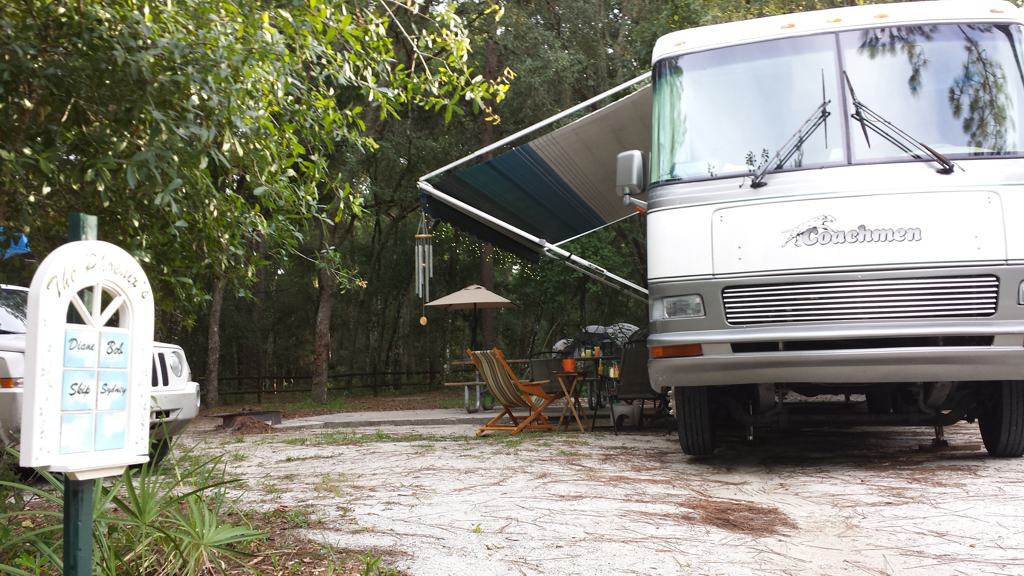Tires are what keeps our RVs running down the road — and there are some things you should keep in mind about your RV tires to keep them in good shape to avoid the damage of a blow-out, or worse, an accident.
Of all the things on a vehicle, tires are often forgotten.
Out of sight, out of mind, right?
Well, there’s a lot to know about your camper tires.
Milk doesn’t last forever and neither do tires.
I guarantee that the tires on the new RV you bought new are older than the RV.
This may sound like common sense, but I can’t tell you how many people I have talked to are surprised that their tires are in some cases a year or more older than their coach.
A tire’s age is determined by its birth date, not the date on which it was installed.
Its birth date is stamped right on the sidewall, and it’s called a DOT code.
The first two digits are the week, and the second two are the year the tire was produced.
RV tires age out before they wear out in most cases.
Once a tire gets to five to seven years of age, they should be inspected by a tire professional annually for signs that they’re failing.
The industry generally agrees that after 10 years, especially when the tires are heavily loaded, they should be replaced, regardless of wear.
In addition, signs of tread separation and sidewall cracking are a good indicator that the tire should be replaced.
Most RVers will junk their camper’s tires that have a lot of tread left on them just because the tires have gone beyond their age of service.
There is some question about the predictability of tire age replacement dates, and it varies from manufacturer to manufacturer.
Having seen the kind of damage tire blow-outs cause, I prefer to err on the side of safety.
Michelin tire says “While most tires will need replacement before they achieve 10 years, it is recommended that any tires in service 10 years or more from the date of manufacture, including spare tires, be replaced with new tires as a simple precaution even if such tires appear serviceable and even if they have not reached the legal wear limit.”
The Recreation Vehicle Industry Association also says in their technician textbooks: “Unlike passenger car tires that are typically replaced due to tread wear, many RV tires will exceed their useful casing life before the tread is worn beyond limits, due to limited miles traveled each year. The typical “life” of a tire is between five and seven years, regardless of tread wear. Tires deteriorate more quickly when used less frequently, such as long storage periods or in a spare tire position.”
Replacing the tires on your RV
What kind of tire should you get as a replacement?
Here are a few thoughts.
First, it’s best not to change tire size from the original, especially for motorhomes.
The coach’s computer is programmed for a particular size and may need to be reprogrammed to keep your speedometer and transmission shift-points the same.
Never under-size your tires from a standpoint of load range just to save money.
I had someone complain to me recently that they had been given a ridiculous quote for new RV tires and that they found the same size much cheaper by calling around.
The cheaper quote was for tires that had a lower load range.
If that RVer had purchased the cheaper tire, he would have been in trouble!
Load ranges are important, and are also generally posted on the side of the tire.
The load range indicates the maximum load the tire is rated to carry, and is an indication also of the axle rating, or the amount of weight the axle can safely carry.
These two numbers are matched when the vehicle is built, and the tire rating never lowered.
It is technically OK to put a higher rated tire on your RV, however the weight rating of the axle and the coach remains the same.
Trailers should have ST or Special Trailer tires on them, not passenger car or light truck (LT) tires.
The reason is that trailer tires are designed to handle different stresses than other tires because of lateral scuffing and so on.
While LT tires can be used, the tires must be de-rated by 10 percent to account for the construction differences.
Selecting tires for your motorhome can be a hard decision especially if you have a larger coach.
Large bus and truck tires are quite a bit different from car and light truck tires.
Their designs are often broken down into wheel position types, like all position, steer tire, trailer tire, drive tire and so on.
Most folks don’t drive their RV in severely inclement weather conditions, and therefore don’t need aggressively treaded tires on their coach.
Many tire dealers will put an all position general use tire on all the tire positions which makes for a quieter and more comfortable ride at a lower cost for the same size and load range tire.
If you think that you’d like a more ‘all-season’ tread design, for use during the winter, for example, talk to your dealer or tire service about this before buying tires.
Just know that a more aggressive tread will increase road noise and may slightly reduce fuel economy, although probably not noticeably.
Taking care of your RV’s tires
Taking care of your RV’s tires is very important if you want them to last a long time.
Factors for taking care of your tires include sun exposure, cleanliness, inspection for wear and proper inflation.
Proper inflation of RV tires is not only important from a longevity standpoint, but is important from a safety standpoint.
Your tires must be inflated properly to ensure both.
Over inflated tires will wear prematurely.
Underinflated tires have to endure more flex than they were designed to do and results in accelerated side tread wear, overheating and the danger of carcass failure and/or tread separation at speed.
Such a failure at speed can result in damage to the vehicle, loss of vehicle control leading to an accident, injury or even death.
While following the inflation recommendations on the tire sidewall is safe, there is a better way.
The reason you don’t necessarily want to follow that pressure is that if your RV is light, then that pressure may be too high, resulting in accelerated center tread wear.
The best way is to weigh your RV.
Overweight RVs are a huge problem, which leads to axle problems, accelerated suspension wear and failure as well as tire failure.
Most trailer tire failures are as a result of the RV being overweight.
Tire manufacturers have load/inflation charts for each model and size of tire they produce to indicate optimum inflation for their tire based on the load it’s carrying.
The RV Safety and Education Foundation has produced excellent guides to weighing RVs and is available on their website at www.rvsafety.com.
Your RV also should have a tire inflation guide sticker or chart posted in or on the coach.
It is important to note that this guide is for the original setup of the vehicle with the original tires, so if the tires have been changed, especially to a different size or rating, this chart should be replaced with new information.
Caring for the tires you have is simple.
Keep them clean, keep them inflated to the proper pressure, and keep them covered to reduce the effects of UV exposure from the sun.
Park the RV on a solid surface and out of the dirt and mud if possible.
Plain boards work fine, but there are also a fair number of lighter weight alternatives available commercially.
Heavy duty poly cutting boards also work well.
Lastly, never use tire dressings on RV tires that contain petroleum distillates as they will degrade the surface of the rubber leading to premature cracking.
Tires contain chemicals in the rubber (anti-oxidants and anti-ozidant compounds) that help protect the tire from weather cracking.
As the vehicle is driven, the tire moves and these components are spread through the rubber.
Because RVs are driven less frequently, these compounds aren’t distributed normally, and if exposed to the distillates can lead to cracking.
Covering and cleaning is the best thing you can do for them.
Each RV tire manufacturer has a guide for RV tire owners, and you can find them here:
http://www.michelinrvtires.com/reference-materials/tire-guide-warranties-and-bulletins/
http://www.goodyearrvtires.com/pdfs/tire-care-guide.pdf
http://www.bridgestonetrucktires.com/us_eng/rv/index.asp
http://toyotires.com/tires-101/rv-tire-care
OK, this is a lot of information to digest, but if you take good care of your tires, they’ll take good care of you!
Happy RVing!



